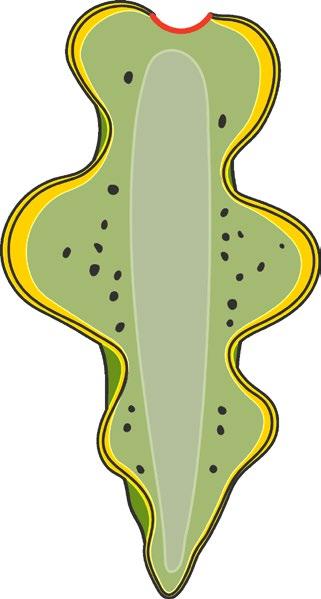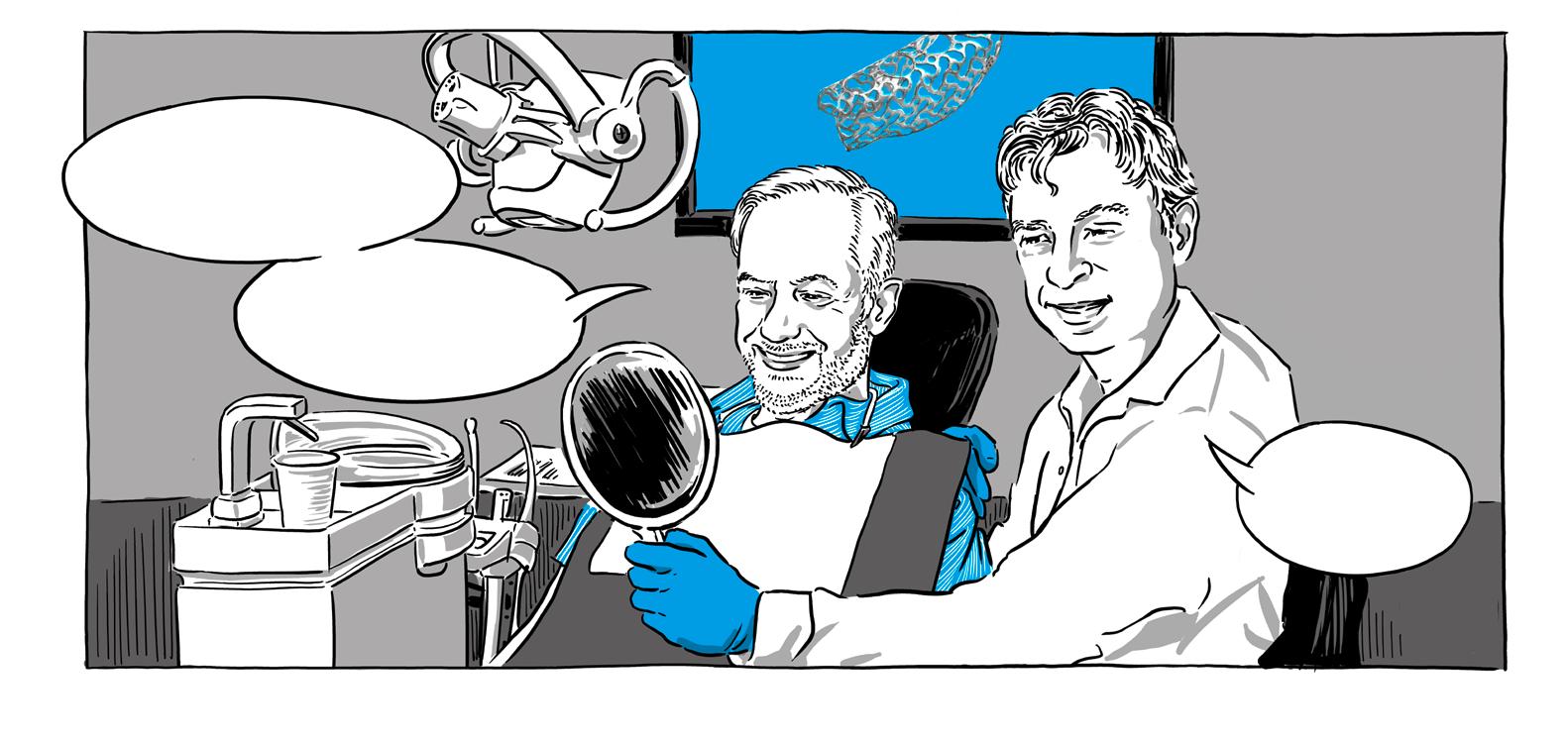
7 minute read
A head without a body
Sacoglossan sea slugs have the ability to rid themselves of – and subsequently regenerate – their entire body, including their heart and digestive system. Japanese researchers suspect that parasites and algae play a vital role in this phenomenon.
For some species of animals, the voluntary amputation (and subsequent regeneration) of certain body parts is an effective mechanism for escaping from danger. Lizards are one well-known example of this process, which is known as “autotomy” or self-amputation. The reptiles can avert predators by shedding their tail – which then grows back again, albeit in a shorter form.¹ In response to danger, African species of spiny mouse from the genus Acomys also shed their skin, which is then regenerated in all of its layers along with the fur and glands.2
Likewise, the Atlantic ghost crab has the ability to shed multiple extremities at predetermined breaking points and to then regenerate these bit by bit during subsequent molting processes.³
However, as Japanese researchers have recently reported, the true masters of regeneration are the sacoglossan sea slugs.4 These sea-dwelling animals are able to amputate their head and then completely regenerate their body.

Spontaneous separation of head and body
As is so often the case in science, chance played a crucial role in this discovery. The doctoral student Sayaka Mitoh was actually keeping sea slugs of the genus Elysia in order to study their life cycle. But one day she observed that one of her slugs’ heads had separated from its body and was moving around on its own.⁵
Of the 15 specimens from the species Elysia marginata kept in the laboratory, a third of them spontaneously amputated their head from the rest of their body over a period of time. Prior to this division, an indentation could be discerned across the slugs’ “necks”, acting as a sort of predetermined breaking point.
A new body within 20 days
Immediately after amputation, the head would begin to move around autonomously, and the wound in the slug’s neck would close up within a day. “We thought that the slug would die soon without a heart and other important organs, but we were surprised again to find that it regenerated the whole body,” explains Mitoh.⁵ The sea slug’s heart regenerated within seven days, and its entire body within 20 days. In addition to the heart, the kidneys, digestive system, a large part of the reproductive organs and the wing-like side appendages had also grown back.
Interestingly, the body only regenerated in young animals, whereas the older ones died off within 10 days. Likewise, the headless bodies could not be regenerated, but they continued moving around for days or even months and responded to touch before they ultimately shrank and perished. By that point, 80% to 85 % of the total body mass had been lost.
Are parasites the reason for autotomy?
Of the second species kept in the laboratory, Elysia atroviridis, 82 individuals were infested with parasites known as copepods. Three of these specimens autotomized and regenerated as described above, thereby ridding themselves of their parasites. A further 39 lost precisely the parts of their bodies that were infested with their uninvited cohabitants. In contrast, none of the 64 unaffected individuals severed a body part.
According to the authors, the obvious conclusion is therefore that sacoglossan sea slugs evolved this capacity for autotomy in order to free themselves of such parasites. Indeed, thanks to their effective camouflage and the presence of toxins in their bodies, sea slugs have relatively few predators⁶ – who are, of course, the reason for the voluntary abandonment of certain extremities in many other animals.
Predetermined breaking point
The sea slug Elysia marginata The body dies after days to months (view from below)


More reproductive success without parasites
Moreover, “feeding experiments” revealed no autotomic behavior. At the same time, the parasites are more than just a nuisance: they fill the majority of the space within the sea slugs’ bodies and thereby hinder their reproduction. If the parasites are “thrown away,” a considerable improvement is seen in terms of reproductive success.
Other theories suggest that discarding the body might also be a way for the animals to prevent themselves from becoming entangled in algae or to dispose of toxic substances in the body. They live only from light
Another unusual characteristic of the sea slugs appears to play a decisive role in this extreme form of autotomy. Specifically, sacoglossan sea slugs feed on algae, ingesting their chloroplasts and storing them as “kleptoplasts” in special intestinal areas under the skin via their highly branched digestive systems.⁶
The Japanese researchers suspect that the amputated heads acquire energy from the chloroplasts’ photosynthesis. Indeed, they have observed that the heads of young sea slugs begin feeding on algae within just a few hours. As the complete lack of a digestive system meant it was no longer
Day 0
The servered head moves around on its own
A fully grown slug Day 7
The heart grows back
Day 22
All organs have been restored Day 14
The wing-like appendages are visible possible to digest algae in the normal way, the energy obtained from the chloroplasts appears to be sufficient to regenerate the rest of the body.
As yet, it is not clear how the sea slugs are able to extend the life span of the chloroplasts, especially given that the environment inside animal cells is characterized by completely different conditions to those in plant cells.⁷ Fluorescence analyses suggest that the animals make the inside of the chloroplasts more resistant, thereby protecting them from lightinduced damage.
Sufficient energy to regenerate the body
Although the efficiency of these tiny sugar producers is reduced, the quantity of energy appears to be sufficient to regenerate the body and to keep the sea slug alive – even for its entire lifetime.
In another study, sea slugs of the genus Elysia survived in an aquarium without food for up to nine months simply due to the influx of light.⁸ This is a period equivalent to their typical life span in the wild.
References 1 Higham TE, et al.: Physiol. Biochem Zool 2013; 86: 603-10.
2 3 Cormier Z: Nature. September 26, 2012.
Pfeiffenberger JA, et al.: J Exp Biol (2021) 224 (10): jeb233536. 4 Mitoh S, et al.: Current Biology 2021; 31 (5) 233-34. 5 https://www.sciencealert.com/self-decapitating-seaslugs-can-grow-a-whole-new-body-internal-organsand-all
6
7 8 Rumpho ME, et al.: Plant Physiology 2000; 123 (1): 29-38. Havurinne et al.: eLife2020 Oct 20;9:e57389.
Giménez-Casalduero F, et al.: Anim Biodivers Conserv 2011; 34: 217-27.
THE TRULY PATIENT CENTERED SOLUTION
How MARCUS SEILER invented a new bone regeneration method for large defects .
Yes. I wish there was a way we could have more vascularized and predictable bone after grafting.
Could 3-D printing help to create a titanium, ridge-shaped scaffold that would guide new bone formation?
It can reduce surgery time and improve precision and predictability.2-3
Here are the quality control requirements.
These are the requirements for regulatory approval.
Let’s make sure clinicians use tested and approved tools and not poor copies.
Something which could save the patient from harvesting morbidity and us from such surprises. Has the bone block resorbed?
Filderstadt, 2006
Full-arch rehabilitation after grafting with autologous bone block
Titanium Clinically tested material1
3-D printed Customized for each patient and each defect – no need to adjust in-situ2

GBR principle I use my trusted and predictable Geistlich biomaterials
3-D printed ridge-shaped scaffold for bone regeneration
Geistlich Pharma HQ, 2010
GBR with a 3-D printed customized mesh becomes a clinical reality
Business support Clinical evidence
Quality and manufacturing R&D
Intellectual property Market approval
Send the CBCT or intraoral data to ReOss® .
7
Place implants and prothesises in the new bone.
6

When the mesh is removed, the newly built bone is vascularized and vital.
2
Order the products after design and planning by ReOss® .
5
Geistlich Bio-Oss® serves as a scaffold for new bone and ensures predictable bone regeneration.4
Protection, wound stabilization and homo geneous vascularization with Geistlich Bio-Gide® .
5-6
4
3
Production of the customized solution, Yxoss CBR® by ReOss® .
Receive the Yxoss CBR® and the regenerative biomaterials at your clinic.
Scan and explore
Fill the mesh with Geistlich Bio-Oss® and cover it with Geistlich Bio-Gide® .
I thought 3-D printing for medical use is something for the far future.
A truly “personalized” solution for me sounds like the future is today!

It all started with an idea!










